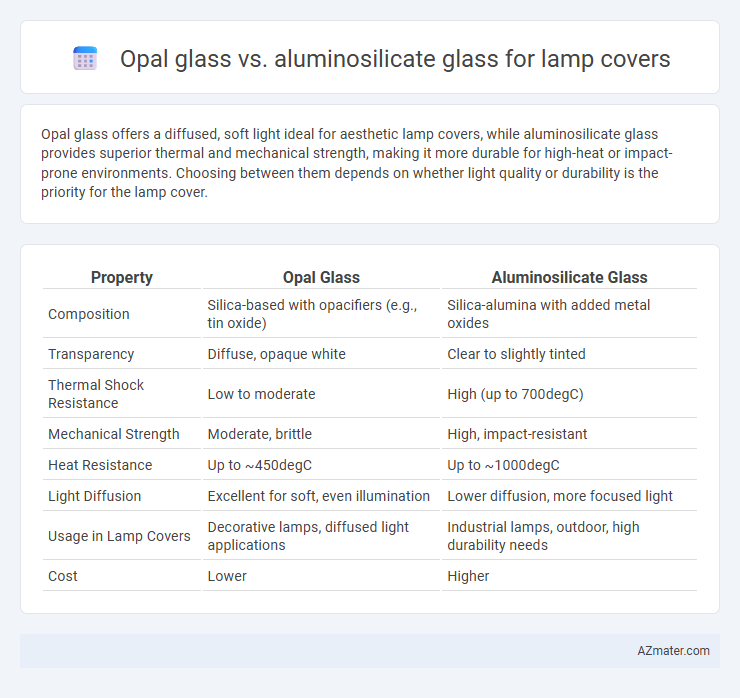Opal glass offers a diffused, soft light ideal for aesthetic lamp covers, while aluminosilicate glass provides superior thermal and mechanical strength, making it more durable for high-heat or impact-prone environments. Choosing between them depends on whether light quality or durability is the priority for the lamp cover.
Table of Comparison
| Property | Opal Glass | Aluminosilicate Glass |
|---|---|---|
| Composition | Silica-based with opacifiers (e.g., tin oxide) | Silica-alumina with added metal oxides |
| Transparency | Diffuse, opaque white | Clear to slightly tinted |
| Thermal Shock Resistance | Low to moderate | High (up to 700degC) |
| Mechanical Strength | Moderate, brittle | High, impact-resistant |
| Heat Resistance | Up to ~450degC | Up to ~1000degC |
| Light Diffusion | Excellent for soft, even illumination | Lower diffusion, more focused light |
| Usage in Lamp Covers | Decorative lamps, diffused light applications | Industrial lamps, outdoor, high durability needs |
| Cost | Lower | Higher |
Introduction to Lamp Cover Materials
Opal glass and aluminosilicate glass are popular materials for lamp covers due to their unique properties. Opal glass provides excellent light diffusion and aesthetic appeal with its milky, translucent finish, enhancing ambient lighting in residential and commercial settings. Aluminosilicate glass offers superior thermal resistance and durability, making it ideal for high-intensity lamps and environments requiring impact-resistant covers.
What is Opal Glass?
Opal glass, a type of opaque or milky white glass, is commonly used in lamp covers to diffuse light evenly and reduce glare, enhancing ambient illumination. It is composed primarily of silica, with small amounts of opacifying agents like tin oxide or bone ash, creating a uniform, softened light output ideal for indoor lighting fixtures. Compared to aluminosilicate glass, which offers superior heat resistance and mechanical strength, opal glass prioritizes aesthetic light diffusion and visual comfort over high durability.
What is Aluminosilicate Glass?
Aluminosilicate glass is a high-strength, heat-resistant material commonly used for lamp covers due to its superior durability compared to opal glass. It contains aluminum oxide and silicon oxide, providing excellent thermal stability, scratch resistance, and impact resilience essential for protecting lighting components. These properties make aluminosilicate glass ideal for applications requiring long-lasting, reliable lamp covers in both residential and industrial settings.
Light Diffusion: Opal vs Aluminosilicate Glass
Opal glass offers superior light diffusion for lamp covers, producing a soft, evenly distributed glow that reduces glare and enhances visual comfort. Aluminosilicate glass, while highly durable and resistant to thermal shock, provides less light diffusion, resulting in a more focused and brighter illumination. Choosing between opal and aluminosilicate glass depends on whether the priority is on diffused, ambient lighting or strength and heat resistance.
Thermal and Mechanical Strength Comparison
Opal glass offers moderate thermal resistance but is more prone to thermal shock compared to aluminosilicate glass, which can withstand higher temperatures up to 980degC and rapid temperature changes without cracking. Aluminosilicate glass exhibits superior mechanical strength with higher fracture toughness and impact resistance, making it ideal for lamp covers exposed to mechanical stress or harsh environments. The enhanced durability and thermal stability of aluminosilicate glass ensure prolonged service life and safety in high-performance lighting applications.
Durability and Longevity
Aluminosilicate glass offers superior durability and impact resistance compared to opal glass, making it ideal for lamp covers exposed to mechanical stress and thermal shock. Its enhanced chemical resistance and higher melting point contribute to a longer lifespan in harsh environments. Opal glass, while aesthetically pleasing with its diffuse light properties, is more prone to chipping and cracking under extreme conditions.
Design Versatility and Aesthetic Appeal
Opal glass offers a soft, diffused light that enhances ambient lighting and complements a wide range of lamp designs with its smooth, matte finish, making it ideal for modern and classic aesthetics. Aluminosilicate glass provides exceptional strength and clarity, allowing intricate shapes and sleek, contemporary designs while maintaining high durability. The choice between opal and aluminosilicate glass balances design versatility with desired visual effects, where opal emphasizes warm, even illumination and aluminosilicate excels in minimalistic, elegant transparency.
Cost and Availability
Opal glass offers a more cost-effective solution compared to aluminosilicate glass for lamp covers due to its widespread production and availability in standard sizes. Aluminosilicate glass, although superior in thermal resistance and durability, tends to be more expensive and less readily available in bulk for decorative lamp covers. Manufacturers often prefer opal glass for budget-friendly projects where standard opacity and diffusion are sufficient, while aluminosilicate glass is reserved for high-performance applications demanding enhanced heat and impact resistance.
Application Suitability for Lighting Fixtures
Opal glass offers excellent diffusion properties, making it ideal for lamp covers that require soft, uniform light distribution in residential and decorative lighting fixtures. Aluminosilicate glass provides superior thermal resistance and mechanical strength, making it suitable for industrial or outdoor lighting applications exposed to high temperatures or impact. Choosing between opal and aluminosilicate glass depends on the specific lighting fixture environment and performance requirements.
Conclusion: Choosing the Best Glass for Lamp Covers
Opal glass offers excellent diffusion and soft light quality, making it ideal for decorative lamp covers that prioritize aesthetics and ambient lighting. Aluminosilicate glass provides superior durability, thermal resistance, and impact strength, suitable for functional lamp covers in harsh or high-temperature environments. Selecting the best glass depends on balancing design preferences with performance requirements, where opal glass excels in visual appeal and aluminosilicate glass leads in robustness and safety.

Infographic: Opal glass vs Aluminosilicate glass for Lamp cover
 azmater.com
azmater.com